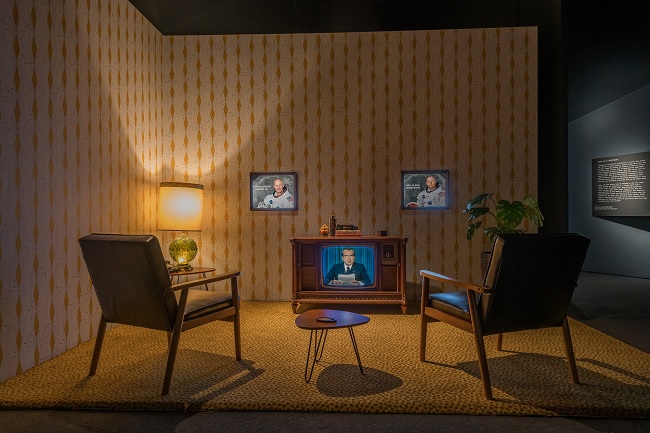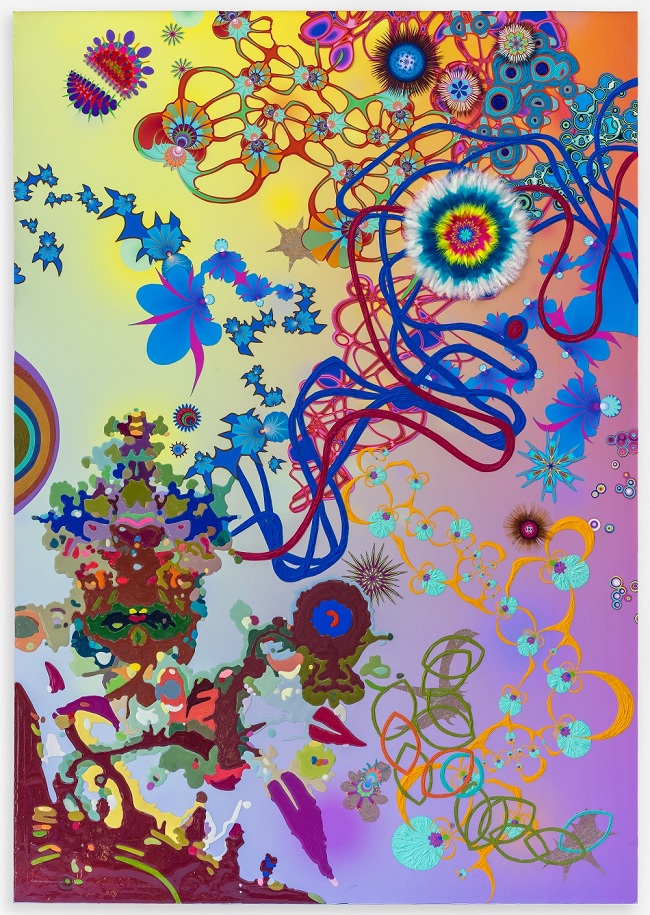Smoke and Mirrors: Magical Thinking in Contemporary Art At the Boca Raton Museum Opens November 18 through May 12
From a media release
Smoke and Mirrors: Magical Thinking in Contemporary Art
At the Boca Raton Museum
Opens to the General Public on November 18 through May 12
- Pre-opening night fundraiser November 17 - check it out [HERE]
As South Florida's museums from Palm Beach to Miami present their highly anticipated offerings for Art Basel Season, the Boca Raton Museum of Art is especially poised to lead the pack with a one-two-punch this year: the world premiere of the Teiger Award-winning exhibition Smoke and Mirrors: Magical Thinking in Contemporary Art, and the sleek new high-speed rail station just blocks from the Museum's front door, luring visitors with a quick escape off the beaten path from the art fairs.
 |
| Imponderable, (film still) by Tony Oursler (5-D feature length film, 90 minutes). |
The new group show was originated by Kathleen Goncharov, the Museum's Senior Curator, and features 30 contemporary artists.
This is the only exhibition in South Florida (and in the entire Southeast U.S.) to win the prestigious Teiger Foundation 2023 Grant Award for Curator-Led Projects – among only 13 museum shows selected nationwide in the Single Exhibition category, recognizing boundary-pushing curatorial work.
The works in this exhibition crack through the looking glass of illusion and beliefs. While performative magic is certainly celebrated here, many of these artists are acclaimed for tackling the thorny issues of disinformation, hoaxes, cults, conspiracy theories, "alternative facts," and the rise of deceptive artificial technologies in our culture.
When exposed, these deepfakes often reveal a greater truth.
According to the Teiger Foundation site, the competition “Acknowledges the uncertainty, fear, and loss in our time of enormous change and supports innovative curatorial work committed to experimentation and creativity in exhibitions, championing curators who engage in the pressing conversations of our time. Curators are thinkers and leaders who play multiple, changing roles in their communities.”
The exhibition is anchored by an entire gallery of phantasmagorical installations by the globally acclaimed artist Tony Oursler, celebrated for asking the pressing question: what happens when the occult is confronted by its mirror image of technology?
Among the 30 artists are: Urs Fischer, Alfredo Jaar, Jim Shaw, Sarah Charlesworth, Glenn Kaino, Christian Jankowski, Kristin Lucas, Jane Hammond, Gavin Turk, Michael Ray Charles, Faisal Abdu'Allah, Mark Thomas Gibson, Robin Tewes, Jeanette Andrews, Stephen Berkman, Jose Alvarez (D.O.P.A.), Jacob Hicks, and The Yes Men.
This timely exploration pulls back the curtain on modern-day deceptions, often perpetrated for political or financial gain – before our very eyes.
Today’s hoaxes, and the blatant lies posted on social media, are often fabricated with new technology yet have earlier precedents in America’s history.
 |
| Merma, by Tony Oursler (fiberglass, resin, acrylic paint, glitter, fake hair, gemstones, video projection, sound). Performance by Dominique Bousquet. |
The exhibition’s temporal twist juxtaposes parallels between our current struggles and the same peculiar fascinations with magical thinking during the late 1800s and early 1900s – when the deadly flu pandemic and World War I created an epidemic of fake mediums, seances, and the golden age of stage magic.
Fast-forward to today, and these artists investigate how the trauma of our own pandemic, climate change, political extremism, violence, and the disruption of societal norms are spurring belief and fascination with the paranormal.
An explosive increase in supernatural characters in popular culture, and dangerous hoaxes that are proving difficult to discredit, are rampant again now.
“Our City is honored by this national acclaim, and that this museum exhibition is the only one in the entire Southeastern U.S. selected by the Teiger Foundation 2023 Grant Award for Curator-Led Projects in the single exhibition category,” says Scott Singer, the Mayor of Boca Raton. “We are proud of the stellar team at the Boca Raton Museum of Art for shining the national spotlight on South Florida’s museum scene.”
“The caliber of the contemporary artists in this exhibition is earning major attention for the new season at the Boca Raton Museum of Art,” says Irvin Lippman, the Executive Director of the Museum.
“The correlation between magic and artmaking has always loomed large, and this exhibition takes this idea one step further, revealing strong connections between today and earlier periods in history when crises led to magical thinking. Art itself is a process of alchemy, transforming physical medium into illusions of beauty, messages that have the power to both inspire and manipulate audiences,” adds Lippman.
Cracks through the looking glass of illusion and beliefs.
 |
| Levitating Woman, by Sarah Charlesworth (Cibachrome with lacquered wood frame). Courtesy of Paula Cooper Gallery. ©The Estate of Sarah Charlesworth. |
Highlights from the Exhibition
The largest gallery in the exhibition is transformed by Tony Oursler into an otherworldly landscape titled Creature Features.
The Museum has commissioned several new installations by Oursler, exploring what the artist calls the “delicate balance between creativity, mysticism and scientific ingenuity.” Based on American folklore, legends, and hoaxes likened to today’s urban myths, viewers will walk into a dream world where the artist’s collection of the unbelievable comes to life.
Tony Oursler is one of the world’s foremost pioneers of video art, working with moving images, installation and projection.
His inspirations include conspiracy, mysticism, narrative evolution and facial recognition technologies. Viewers are often disoriented and disarmed upon entering his installations.
Oursler’s video art is celebrated for transcending traditional screens, TV monitors and surfaces. His work jumps out at viewers via visual experimentation, described by his gallerists as harking back to camera obscura and psychedelia – through the surreal environments he creates with bots and intimate digital effigies, optical devices, sculptures, and ethereal talking automatons.
Central to Oursler’s work is his endless fascination with how technology impacts humanity. For several decades, the artist has amassed a vast archive of more than 3,000 historical materials pertaining to the paranormal fringes, pseudo-science that connects to cults, and the intersection of science and the occult.
The realms of magic and illusion are generationally embedded into the artist’s DNA. Oursler’s grandfather was a magician who exposed trickery used in seances by the Spiritualists of his era, who lied to desperate widows yearning to communicate with relatives who died in World War I.
Oursler’s father founded the magazine Angels on Earth, about spiritual encounters. The artist’s spirit world fascination also includes his admiration for mediums and mystics who never charged for their services, falling outside the realm of financial fraud.
 |
| Imponderable, (film still) by Tony Oursler (5-D feature length film, 90 minutes). |
In 2000, Oursler was awarded the U.S. Art Critics Association ICA New Media Award. Oursler has been selected for solo exhibitions throughout the United States and is currently one of America’s most internationally exhibited artists (with solo shows in more than 25 countries).
Imponderable, Oursler’s cinematic 5-D experience, has only been exhibited at MoMA in New York and was created using Pepper’s Ghost, a mirror illusion technique first used in the 1800s in theatrical ghost plays.
Other installations in Oursler’s Creature Features landscape include: Fairy (a fantasy projection of a performance by Katiana Rangel); Cardiff Giant (Oursler’s never-before-seen life-size recreation of one of the most famous archaeological hoaxes in American history); Flatwoods Monster (a re-living of the 1952 legendary UFO extraterrestrial folklore encounter); Alice Cooper Head (inspired by The Amazing Randi’s infamous creations for Alice Cooper’s concert tour in the 1970s); Crystals (created in part with artificial intelligence, exploring the digital divine, 5-D technology, near-death experiences, and hallucinogenic states); Charles Doyle Fairy Painting (based on his fantastical paintings of Victorian-era fairies and other fantasy themes); and Merma (described as “beautiful in a horrifying way”).
Parallels between our current struggles and the same peculiar fascinations with magical thinking during the late 1800s and early 1900s.
 |
| The original Cardiff Giant at the Farmers' Museum in Cooperstown, New York, where it is still displayed (Photo by Martin Lewison/CC2.0). |
The trauma of our own pandemic, climate change, political extremism, and violence are spurring belief and fascination with the paranormal.
 |
| Francesca Panetta and Halsey Burgund’s installation In Event of Moon Disaster |
Francesca Panetta and Halsey Burgund’s installation In Event of Moon Disaster was made using sophisticated deepfake technology. In 1969 most of the world celebrated the Apollo 11 crew’s first successful moon landing, the exceptions being conspiracy theorists claiming it was all staged. In this work, Panetta and Burgund ask: what would have happened if the mission had gone wrong?
Their Moon Disaster installation reimagines this seminal event to illustrate the possibilities of deep-fake technologies. In this alternative history, visitors will time-travel to a Florida living room where Richard Nixon appears on a television set to announce the tragedy.
Dow Does the Right Thing - a media hoax by The Yes Men:
 |
| From The Magician, by Jacob Hicks. Video, computer with internet connection, black electric candles, computer tablet, crystal bubble vase, table (2023). |
 |
| Jeannette Andrews. Photograph by Saverio Truglia. |
 | |
| The Illusionist, by Jose Alvarez (D.O.P.A.). Acrylic, colored pencil, ink, pastel, handmade paper, feathers, quills and collage on paper ( 2021). |
The Amazing Randi
 |
| Trial by Fire by Sarah Charlesworth (Cibachrome with lacquered wood frame). ©The Estate of Sarah Charlesworth. Courtesy of Paula Cooper Gallery. |



Comments
Post a Comment